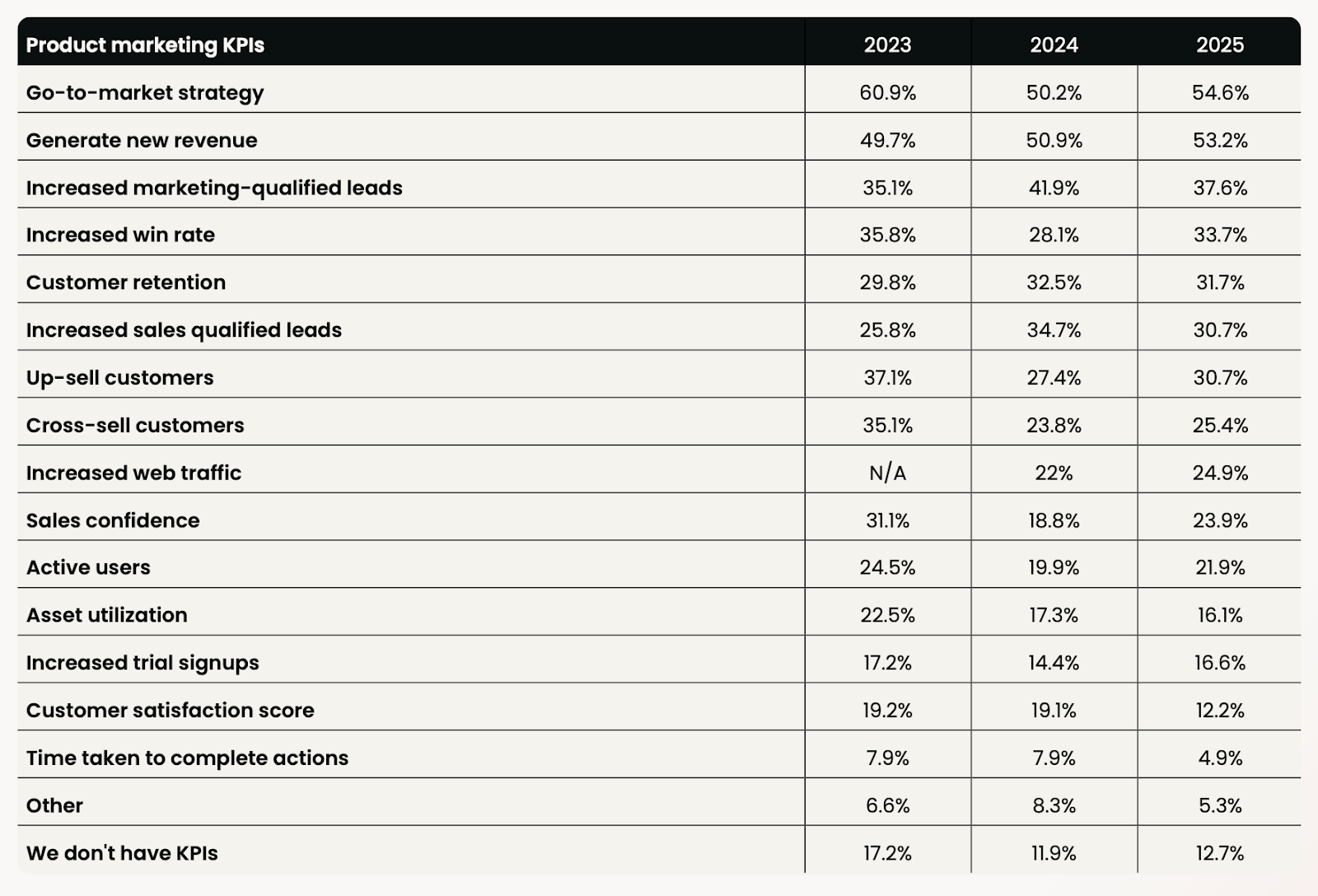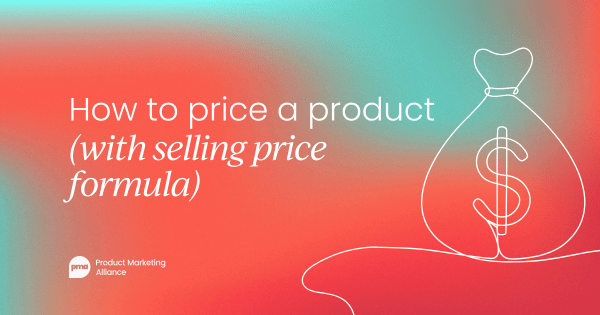The State of Product Marketing Report found that go-to-market is still the main product marketing KPI in 2025, with 54.6% of PMMs ranking it at the top.
But why is that?

GTM is a core mandate of product marketing
Product marketing is one of those roles that can look very different from company to company.
Some teams lean heavily into sales enablement, others into growth, others into messaging. But the throughline across many PMM job descriptions tends to be “bring the product to market and make sure it succeeds there”.
This matters because, without GTM, product marketing might become a support function (e.g., making decks or writing copy).
Go-to-market ownership keeps PMMs at the strategic center. After all, if you can demonstrate GTM success, you prove you’re not just a storyteller or a campaign manager, but also a growth driver.
For instance, a PMM might do competitive intelligence or persona interviews, but those activities only matter if they help create a GTM plan that drives adoption.
“Go-to-market strategy isn’t one-size-fits-all. This might seem obvious, but it’s worth emphasizing. You can’t create a single GTM strategy and expect it to apply to every launch or campaign throughout the year. Markets are dynamic, and customers are constantly evolving. Each launch or campaign will have unique nuances, so you need to tailor your approach.” – Bryan Dsouza, Head of Marketing for AI/ML, Mobility & UX at Aptiv
GTM as the bridge between product and market
A go-to-market strategy is often at the intersection of product development and customer adoption, making it the best way to measure whether product marketing is successful.
It also tells the full story: did the product actually make it to market in a way that resonated with customers? A product can be built to perfection, but if it launches with the wrong message, or to the wrong audience, or even at the wrong time, it won’t gain traction.
Measuring GTM performance allows you to validate just how ready your product is, as well as the maturity level of your entire process. A strong GTM means that positioning is clear, competition is accounted for, pricing is validated, and sales enablement is locked in.
It’s the KPI that proves product marketing isn’t just about crafting stories but about driving outcomes.
That’s why, even as product marketing evolves and the discipline takes on new responsibilities, GTM remains the north star. It’s about launching products, but it’s also about ensuring products land with impact.

GTM as the engine of growth
GTM links storytelling and financial performance. This is because a well-executed GTM strategy can lead to higher revenue by equipping sales teams with the right tools and making sure buyers have been told the right narrative. Additionally, the market should also understand your value proposition from day one.
On the other hand, a weak GTM strategy harms your revenue even if your product is great. You might see longer sales cycles, confusion in the market, or lost deals to competitors with inferior offerings but better positioning.
When organizations treat GTM as the primary KPI, they align PMM closer to business outcomes. It means product marketers can demonstrate that their work (research, messaging, enablement, competitive analysis) directly translates into revenue growth.
This further helps to move PMM away from being perceived as a support function and into a role of strategic importance, as we mentioned above.
A successful launch also goes beyond initial sales because it creates momentum that improves your pipeline and your win rates, as well as your customer advocacy.
“A great GTM strategy is built on positioning, timing, iteration, and you know, just really understanding what's coming next. [...] A successful go to market motion depends on you, the product marketers, to strategically lead the charge observing the landscape and bringing people together to create real impact.” – Emily Robertson-Yeingst, Fractional Chief Product Marketing Officer
GTM works cross-functionally
Product marketing is one of the few functions that touches every team:
- Product: Works with PMMs on roadmap, feature prioritization, and differentiation.
- Sales/CS: Delivers enablement, competitive intel, objection handling, and success stories.
- Marketing: Shapes campaigns, demand gen, and content around positioning.
- Leadership: Communicates how launches tie to strategic objectives.
“Basically, from strategic planning and crafting strategies supported by all teams to testing and gathering insights and influencing the product roadmap directly, [GTM is] accounted for by product and all the way down to KPI setting.
“In the context of a go-to-market launch, what is a good go-to-market, what is a not so good go-to-market, we should absolutely be able to assess that at every point in time.” – Thibault Oberlin, Sr. Product Marketing at PayFit France
A GTM plan forces all of these groups to pull in the same direction. Without PMM leading GTM, your product launches might become fragmented.
For instance, the product teams might focus on features, while sales on pricing/discounts, and marketing on brand awareness, but PMMs can unify these into one narrative and execution plan.
“I'm very fortunate because, at Atlassian, they really equate PMM with go-to-market. So we really own the go-to-market, and we actually tell the other teams ‘This is what I want you to do. This is how we're gonna get there.’” – Daniel Kuperman, VP of Product Marketing at Jellyfish (ex-Atlassian)
GTM is repeatable and scalable
GTM is a process, so if you treat it as your primary KPI, you can more easily develop launch models and playbooks that can be rolled out across products and customer segments.
Early-stage companies use GTM to test positioning and tweak product-market fit, growth-stage orgs rely on repeatability to scale launches across regions or verticals, and enterprises use GTM frameworks to ensure consistency across big portfolios with many launches a year.
A repeatable GTM framework is key, as you don’t have to reinvent the wheel after every launch. So, if you do it well, you can more easily execute and turn speed-to-market into your competitive advantage.
GTM as competitive differentiation
Speaking of which, Gartner research shows that industry competition (51%) is one of the most common GTM challenges companies face. So, differentiation is often the deciding factor.
A product can have superior features, but if your GTM doesn’t communicate that effectively, competitors will win on narrative.
By measuring GTM performance, you can assess whether your competitive positioning resonated enough for customers to choose your product over someone else’s.
A good GTM performance includes reaching the right segments, activating the right brand advocates, and giving sales the competitive intelligence they need to win. It shows whether your organization can take market share, not just introduce a product.
Competitive differentiation is also dynamic. Your competitors will respond to your launch, attempt to copy your messaging, or escalate their campaigns. GTM as a KPI captures how well your strategy holds up against these pressures.
A strong GTM strategy positions you effectively at launch and sustains that as the market reacts.
Your GTM performance will also show any blind spots you might have. If your product adoption is moving slower than you expected, it may mean your competitors have won. This feedback is important for refining your positioning, pricing, and sales strategies moving forward.
GTM for customer adoption and retention
A successful GTM strategy sets the stage for adoption and long-term retention. Customer success teams may own renewal targets, but the foundation is often laid by product marketing during GTM strategies.
As mentioned, when adoption lags, it could be an issue with your go-to-market strategy. Perhaps the value proposition wasn’t clearly articulated, onboarding content was misaligned with user needs, or early adopters weren’t nurtured into advocates.
Retention is also influenced by GTM. If you overpromise in your messaging, customers might feel misled, but if you underplay what makes you unique, your competitors might win. A clear and compelling GTM strategy helps you set realistic expectations that match the value of your product.
Ultimately, GTM as a KPI ensures that PMMs aren’t just focused on acquisition. It connects marketing and sales efforts to the customer lifecycle, proving that product marketing influences retention as much as it does initial revenue.
Final thoughts
Go-to-market remains a key KPI for product marketers because it involves everything the role is meant to be, from connecting the product to market to aligning teams, driving adoption, and proving business impact.
PMMs create messaging, research, and enablement, and GTM showcases whether those efforts truly resonate in the real world.


















 Follow us on LinkedIn
Follow us on LinkedIn





.svg)
Start the conversation
Become a member of Product Marketing Alliance to start commenting.
Sign up now